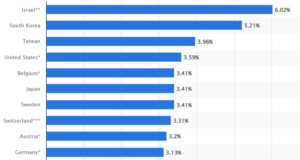
The Indian economy is at a cross roads — it requires a significant increase in budgetary support innovation to achieve sustainable growth. While the country has managed to address resource constraints, it must shift towards a more structured and well-supported plan to realise its economic potential. India is facing several challenges posed by insufficient funding for R&D. It needs a comprehensive and strategic approach towards innovation and development, emphasising the role of government in fostering a culture of innovation.
India is renowned for its ability to thrive on ‘jugaad’ innovation which involves creative ways to work around constraints. During the COVID-19 pandemic, this approach allowed people to manage with limited resources through creative solutions. However, in the current context, investment in research and development (R&D) is crucial for India to become a self-reliant economy. The 2020 launch of Atmanirbhar Bharat campaign encourages the Indian economy to become more self-sufficient, necessitating significant R&D investment.
READ I Car exports dream stalled: Can the industry shift gears by 2030?
Low investment in R&D
Despite government efforts, the share of GDP spent on R&D decreased from 0.8% in 2010 to 0.6% in 2018. This is minimal compared to the 2018 R&D spending in countries like South Korea (4.8%), China (2.2%), Japan (3.2%), Germany (3.0%), and the United States (2.8%). Government funding constitutes the majority of R&D spending in India, where high technological exports are associated with higher R&D expenditures. India’s high-tech exports constitute 9.1% of its exports, compared to 31.4% for China and 36.3% for South Korea. Increasing R&D investment is essential for import-dependent industries to move up the manufacturing value chain and become more competitive.
India’s gross expenditure on R&D (GERD) is lower than that of other BRICS countries. South Africa, China, Russia, and Brazil spend approximately 1.2%, 1.1%, over 2%, and 0.8% of their incomes, respectively, while the global average is around 1.8%. According to the India Innovation Index 2021, R&D spending in India remains low nationwide, at about 0.7% of GDP. In contrast, developed nations like the United States, Sweden, and Switzerland spend roughly 2.9%, 3.2%, and 3.4% of their GDP on R&D, respectively, with Israel having the highest rate at 5.5%.
R&D spending as share of GDP

One reason for low R&D spending in emerging nations like India is the delayed return on investment. Larger issues like hunger, disease control, and improving living standards take priority. However, these urgent issues should be viewed as opportunities to expand R&D rather than barriers. Low GERD spending can lead to brain drain, where talented individuals move elsewhere in search of better opportunities, reducing a state’s competitive advantage and negatively impacting the national economy.
While government funding plays a crucial role in R&D, the involvement of the private sector is equally important. Currently, private sector investment in R&D in India is relatively low compared to other major economies. For instance, in countries like the United States and South Korea, private sector contributions significantly boost their overall R&D spending. Encouraging private enterprises to invest in research and development can lead to innovative products, processes, and services that enhance economic growth. Policies offering tax incentives, grants, and public-private partnerships can stimulate private sector investment, driving India towards a more balanced and robust R&D ecosystem.
Updates on innovation
The government has pledged support for research and innovation for India’s “tech-savvy youth” with a ₹1 lakh crore corpus available at minimal or nil interest rates to encourage private sector R&D investment in “sunrise sectors” during the Interim Budget speech on February 1, 2024. This corpus aims to foster broad or specific research under certain ministries. The National Research Foundation (NRF) plays a crucial role in R&D.
The Department of Science and Technology (DST), Department of Biotechnology, Council of Scientific and Industrial Research (CSIR), and Ministry of Earth Sciences (MoES) received modest funding increases. The CSIR’s funding increased by 10% from ₹5,746 crore in 2023-24 to ₹6,323 crore, while the DST saw a 1% increase from ₹7,931 crore to ₹8,029 crore. For the first time, ₹2,819 crore was allocated to the National Quantum Mission, aimed at developing technologies based on quantum mechanics with applications in computing and cryptography.
The way ahead
To reach its target of a $5 trillion economy, India’s GERD must improve significantly, aiming for at least 2% of GDP. The Interim Budget 2024-25 allocated ₹13,208 crore for R&D, up from ₹12,850 crore in 2023-24. Actual spending from January to December 2023 was ₹12,943 crore. India must have a clear budgetary plan for investing in R&D and innovation. Increased R&D spending is crucial for India to become an Atmanirbhar Bharat and achieve a $5 trillion economy. This can be accomplished through unprecedented investment in innovation, moving beyond the reliance on jugaad.
Investment in education and skill development is fundamental to fostering a culture of innovation. A well-educated and skilled workforce can effectively contribute to R&D and drive technological advancements. Strengthening the education system, particularly in science, technology, engineering, and mathematics (STEM) fields, is essential. Additionally, vocational training and continuous skill development programs can prepare the workforce to meet the demands of evolving industries. Collaborations between educational institutions and industry can ensure that the curriculum remains relevant and that graduates are equipped with the necessary skills to contribute to India’s innovation landscape.
India stands at a critical juncture where strategic investments in R&D, coupled with comprehensive policy reforms, can transform the economy. Moving beyond jugaad innovation to a structured and well-supported R&D framework is essential for achieving sustainable and inclusive growth. By fostering private sector participation, enhancing education and skills, strengthening IPR, improving infrastructure, and considering environmental and social factors, India can build a robust innovation ecosystem. This holistic approach will pave the way for India to become a global leader in innovation, driving long-term economic growth and enhancing its global competitiveness.
(The author is a research student at the Department Of Economics, School Of Management, Pondicherry University.)
